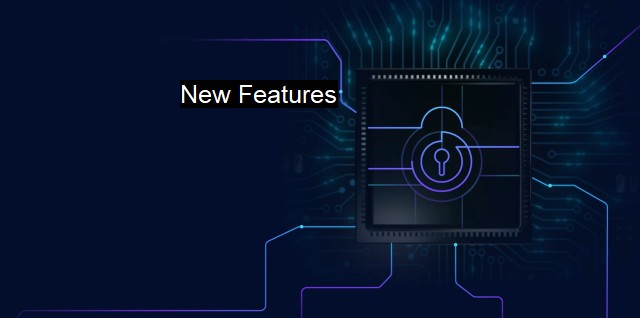What are New Features?
Exploring the Evolution of Antivirus: The Role of New Features in Cybersecurity.
"New Features" within the context of cybersecurity and antivirus are advancements, enhancements, or upgrades in software that create new capabilities. These capabilities are uniquely designed to tackle evolving threats, improve system performance, or make the user experience seamless. New features come from the sustained endeavors of cybersecurity companies to counter mounting and sophisticated cyber threats, providing comprehensive protection to an entity's digital landscape.With the rapid pace of technological advancement, cyber-attacks and security threats are perennially evolving, becoming more complex and harder to detect. This unprecedented acceleration necessitates continuous innovation, producing new features in antivirus and cybersecurity software.
The term "New Features" might refer to numerous features, from improved virus detection and removal capabilities to additional security layers against phishing and other online threats. It might encompass advanced scanning settings to discover hidden or deeply lodged malware or be about intelligent algorithms for detecting suspicious activities on connected devices. Firewalls, website rating systems, parental controls, VPN capabilities, or online transaction protection features are other possible manifestations of ‘new features.’
Considering the advancement in cyber-attack techniques, there is a surge in new features that employ machine learning and artificial intelligence. Today's high-spec cybersecurity software applications commonly feature AI-based mechanisms, algorithms, computations, and filters specifically programmed to detect irregular behaviors, sophisticated threats, false positives, and unfiled threats.
One significant type of new feature in antivirus software relates to heuristic and behavior-based threat detection. Here, the software actively learns evolutionary traits about malware and neutralizes potential threats by probing into the attributes and lineage of the threats. It drastically reduces vulnerability to the newest threats, detecting them before the conduct of any malicious activity—these kinds of modernized features dramatically increase the effectiveness of threat response.
The changing dynamics of the workforce, particularly the shift towards remote working, has affected the domain of cybersecurity and antivirus software. Recognizing potential security loopholes in digital communication networks, software developers now design new features to fortify firewalls and incorporate end-to-end encryption, storing all sensitively encrypted data into decentralized networks to subvert data breaches.
In addition to system-oriented characteristics, new features are often designed with a heightened focus on user experience. Cybersecurity software may now come fitted with intuitive dashboards and graphics, making it easier for users to understand security reports and manage protection settings. Features that minimize computer slow-down during scans and automatic software updates are increasingly becoming standard for modern antivirus software.
New features should not be mistaken as an added luxury but as a pragmatic need in the digitally connected context. Many software developers are now including privacy protection features to address emerging concerns in online privacy. These most recent updates help users remain anonymous online, protect user data from being sent to advertisers or third-party users and also shield their digital identity from being hacked or misused.
"New Features" signify the progress in cybersecurity and antivirus technology. In an interconnected world facing a surfeit of cyber threats, from ransomware to phishing to identity theft, these new features are regularly challenging the status quo, enforcing intelligent and complex features that can thwart nefarious activities on the web. they aim at enhancing the user experience, making the systems more efficient and accessible. As modern malware and threat tactics advance, so do the new features, which are continuously designed to identify, intercept, and neutralize these threats, guaranteeing safer technology systems for everyone.

New Features FAQs
What new features have been added to your cybersecurity software?
Our cybersecurity software now includes advanced threat detection and mitigation capabilities, enhanced protection against malware and phishing attacks, and real-time monitoring of network activity. Additionally, we have added a user-friendly interface and simplified setup processes.What benefits do the new features bring to my organization's cybersecurity?
The advanced threat detection and mitigation capabilities provide stronger protection against both known and unknown threats, ensuring that your organization's sensitive data and systems remain secure. The enhanced protection against malware and phishing attacks helps to prevent costly data breaches and cyber attacks. Real-time monitoring of network activity enables quick identification and response to any suspicious activity. The user-friendly interface and simplified setup processes make it easier for your organization's IT team to manage and maintain the cybersecurity software.Will the new features increase the cost of the cybersecurity software?
There may be a slight increase in cost for the updated version of the cybersecurity software, but the benefits provided by the new features outweigh the increase in cost. Additionally, the cost of a data breach or cyber attack can be much greater than the cost of the updated cybersecurity software.How can I upgrade to the latest version of the cybersecurity software with the new features?
To upgrade to the latest version of the cybersecurity software with the new features, you can typically download and install the updated software from the vendor's website or through the software's built-in updating mechanisms. It is important to ensure that your organization's IT team performs regular updates to the cybersecurity software to ensure maximum protection against cyber threats.| | A | | | B | | | C | | | D | | | E | | | F | | | G | | | H | | | I | | | J | | | K | | | L | | | M | |
| | N | | | O | | | P | | | Q | | | R | | | S | | | T | | | U | | | V | | | W | | | X | | | Y | | | Z | |
| | 1 | | | 2 | | | 3 | | | 4 | | | 7 | | | 8 | | |||||||